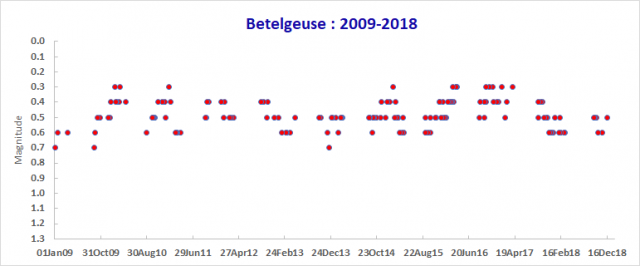› Forums › History › Did Aboriginal Australians Discover the Variability of Betelgeuse? › True Variability vs Scatter
 I do sometimes wonder how much experience authors of articles such as this have of the stars that they are writing about.
I do sometimes wonder how much experience authors of articles such as this have of the stars that they are writing about.
Yes, as the author states “it is easy for inexperienced observers to detect the variability of Betelgeuse over its range in brightness from V = 0.0 to V = 1.3“. However, the key word here is “inexperienced”. Are they really detecting changes in the brightness of Betelgeuse itself, or is it just scatter due to inexperience?.
The major challenge regrading visual monitoring of Betelgeuse is that with it being one of the brightest stars, its comparison stars such as Procyon are a long away from it on the sky – and thus potentially affected to a different extent by factors such as haze. It is easy to “see” Betelgeuse to be “significantly brighter than Procyon” , when Procyon is somewhat lower in the eastern sky and dimmed by haze or “greatly fainter than Procyon” when Betelgeuse is somewhat lower in the western sky.
I have included my light curve from the past 10 years to illustrate that the normal range of Betelgeuse is no more than a few tenths of a magnitude. My observations of Betelgeuse go back around 40 years and, other than when observed under poor sky conditions or when low in the sky, my estimates have not ventured far from the range shown here.
